We have narrated in an earlier article the Shivalinga as we know it from Puranic sources. In this article we will see the rational development of the Shivalinga. In Gujarati it is also called Shiva’s Pendi (શિવની પેંડી – શિવજીની પેંડી). In the Northwest China where Tocharian languages (Indo-European languages) were spoken have several names like Tarim Pendi and Junggar Pendi which means Tarim Mountain and Junggar Mountain. Thus, Pendi means mountain. Siwalika (Siwa-linga) mountain range which is parallel to the Himalayas in Uttar Pradesh and Nepal gives us an indication that Linga may also mean mountain. The original meaning of the word Shiva may have been hard stone or hard substance. We have words in Gujarati like Sheela, Sheesu, Sheesam, etc (શિલા – પથ્થર, શિસું – Lead ધાતું, શિસમ-કઠણ લાકડું, વગેરે) which indicate stone or hardness of the substance associated with the Shiva word. These interpretations will lead us to a definite recognition that the original meaning of Shiva-linga was “Rock- Mountain” which we have forgotten through millennia of natural and manmade traumas.
In the Vedas there is no concept of Linga associated with any of the Devas mentioned in it. Although there is mention of Rudra with some of the attributes associated with Shiva of the Puranic period.
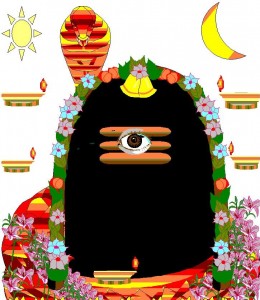
Shivalinga with the Sun Symbol
Our ancient people of the Saraswatisindhu culture had noticed the importance of rivers and especially the River Saraswati for their very existence. They realized that the perennial water in all the rivers comes from the ice clad Himalayan peaks and their glaciers. It wasn’t too difficult for them to see that the sun was the source of heat to melt the ice and snow and create the perennial rivers. This realization created reverence of the sun and mountains in general and Himalayan peaks in particular. This association was conceptualized in the physical form of mountain (Shiva-Linga) and the sun symbol. This pure concept is still practiced in some of the temples. The picture here clearly shows mountain peak (Kailash) with symbolic sun along with some other attributes which developed later. Initially, the Linga had no bund. However, to create the proper mountain and river scenario they added a water pot (Kalash) with constant dripping of milky water over the Linga (Mountain). This dripping water needed a bund (embankment) to channel it into a stream representing a river. This bund initially was square and various other shapes. The classic “Yoni” shape was created during the Bramanic period along with “vagina” meaning.
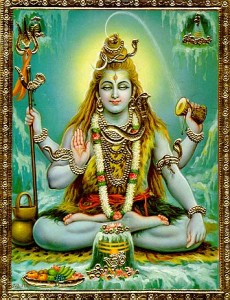
Representation of Lord Shiva in the Human Form
We will now investigate all the aspects associated with Lord Shiva for their ancient meaning. The picture here represents Shiva in human form with all his attributes.
1In the picture above, the Linga represents a mountain and especially the ice clad Mount Kailash in the Himalayas. Kailash is stated as the abode of Lord Shiva.
2The sun is represented on the Linga by the sun symbol. This is to indicate that the sun is melting the ice and snow on the peaks and thus it is the source for the creation of rivers.
3The simulation of natural process of river creation is done by hanging a water pot (Kalash) over the Linga. The Kalash has a hole at its bottom which allows continuous dripping of milky water on the Linga to create a flowing river.
4The so called “yoni” is simply a bund (embankment) to direct the continuously dripping water into a stream which is a representation of river Saraswati. Saraswati thus created in the temple is then normally directed outside into a Tulsi-Kyara (bed in which holy Tulsi plant is sowed). The Tulsi-Kyara represents crops.
5The crescent moon shown with the human form of Shiva represents the ice, snow and coolness on the peaks.
6The Nandi (seated bull) is always present in front of the door of the Shiva temple. It is appropriately called Dwarpal- door keeper. There are several mountain peaks shaped like a seated bull on the way to mount Kailash from the south. Those Nandi like mountains make it difficult to reach Kailash. Therefore, these mountains are depicted in the temples as seated bull and are granted the status of the door keeper in the temples. One of those peaks is shown below with a carved seated Nandi. They do look similar.
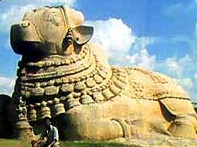
Stone Carving of Nandi
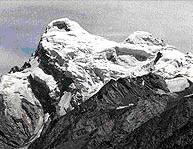
Nandi Shaped Mountain
7The association of Naga with Shiva comes from the shape of the jutting rock at the summit of Mount Kailash. It could be seen clearly in the following picture.
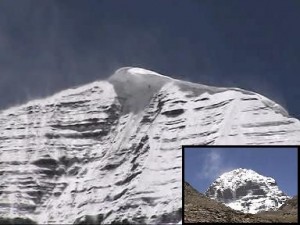
An Enlarged View of Mount Kailash Showing a Cobra Hood like Rock
8The Damaru (tabor) in one hand of Shiva represents the rumbling but rhythmic sound of earthquake which is more precisely shown in the destructive form of Shiva in its Nataraja attributes. The representation of Shiva as a dancer (Nataraja) is a conceptualization of rhythmic movement of the Earth during the earthquake (Trandava Nrutya) and consequent formation of mountains.
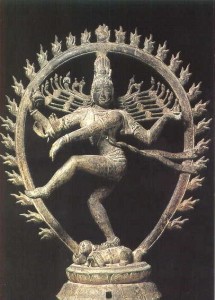
Natraja
9The trident represents the mountain peaks surrounding mount Kailash.
10Rudraksha Mala associated with Lord Shiva represents Himalayan mountain ranges with folds.
The following pictures illustrate the point. The first picture shows the normal Rudraksha Mala used by Sanatan Holy men and it is always associated with representation of Lord Shiva in human form.
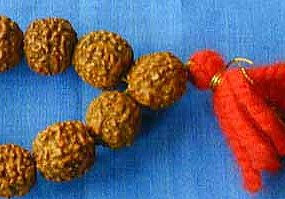
Rudraksha Mala
The next two pictures show the enlarged view of one of the above beads and also an aerial photograph of the Himalayan Mountains. Any rational mind could see the exact resemblance between the two.

Single Bead of Mala
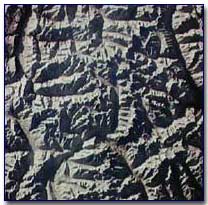
Arial View of the Himalayas
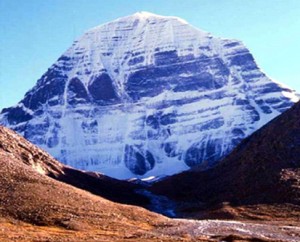
Mount Kailash Showing the Flow of Snow and Ice
11Shiva’s hair (Jata) is always in the form of a mountain peak. The following picture of Kailash shows ice and snow streams as if they form hair on a human head. The concept of a river erupting from Shiva’s Jata comes from this visual effect. The hair like flow of snow and ice forms the beginning of the river. This then was the conceptualization of river Sarswati formation in the temple and shown erupting from Jata in human form of Shiva. Since the loss of river Saraswati, that place is now assigned to river Ganga.
If the prevalent ideas of Yoni, Linga, etc are correct then why do we need milky water dripping on the Linga? In my village temple after worship of Lord Shiva, I have always gone for a round around the temple (Parikrama) and have taken water (Achaman) from the Saraswati which flows out from Kailash (Shivalinga) into Tulsi-Kyara. This act of taking Achaman would with the prevalent concept tantamount to bestiality.
The concept presented here is the only rational explanation for the evolution of the Shivalinga. The fact that the abode of Lord Shiva is in Mount Kailash (Kalash shape) and his consort is Parvati (Parvat = પર્વત, Mountain in Gujarati) also fit correctly with our interpretation. The prevalent paradigm is a creation of fertile but irrational and irresponsible mind aided and abated by wasted interests.
The worship of Lord Shiva in a temple is simply the worship of the natural creation of life giving rivers from the ice clad Himalayan Mountains; especially the River Saraswati from Mount Kailash.

